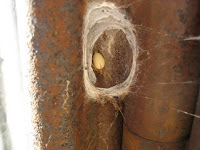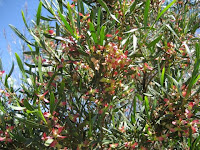 Just before Christmas Day I sent out the following as an email to family, friends and acquaintences as part of a festive season greeting. The response was extremely positive so I've decided to share the experience more widely via publishing on Ochre Archives.
Just before Christmas Day I sent out the following as an email to family, friends and acquaintences as part of a festive season greeting. The response was extremely positive so I've decided to share the experience more widely via publishing on Ochre Archives.During the year Jan and I were driving to Melbourne. We were not long out of Grenfell when we came across a car that had rolled and was resting upside down smouldering. We were 3rd on the scene, with those before us having been there only a minute or 2 before us … an elderly gent in one car and two people (a bloke and a sheila) in their 20’s who were travelling together through their work.
It quickly became evident that driver of the up-turned vehicle (lady … senior citizen) was still in the vehicle and was unable to get out. When I reached the vehicle the elderly gent said to me something like “you’ll have to smash the window to get her out” and he then promptly left the scene. After a quick look I could see that the rear door on the passenger’s side looked to be undamaged. On trying the door handle the door came open easily. The driver was fully conscious, had managed to undo her seat belt, was lying on her back on the ceiling and was, to put it very mildly, relieved to see that there was a prospect of getting out. The other bloke and I spoke with the driver and each other and decided that we’d pull her from the vehicle pronto regardless of the risk of further physical damage to the driver as it was clear it was highly likely the car would soon be engulfed in flames. We moved her as gently as we could, taking her 20 metres or so from the vehicle. Talking to the driver some more it became apparent that her shoulder had been damaged in the process of the car going off the road, rolling and hitting a tree. The cause of the incident was very simple … she’d had one of those micro-sleeps.
Meanwhile Jan had called emergency services (000) on her mobile. We were located out of normal service range so whilst Jan did manage to get through the signal was very dodgy and we were not confident that we’d communicated what was happening and was needed well enough. I then rang from another mobile.
There’s quite a bit more I could go into about the incident, but the most important things to convey are the main learnings for us:
1. If you need to call emergency services it’s useful to remember that those on the other end of the phone have one objective – to glean from you as quickly as they can an accurate brief outline of what the situation is and to convey the message to the appropriate people.
2. Those in the emergency services call centre are unable to access information on other calls that have been made. Thus when I called them to check that Jan’s message had got through OK the person was blunt and got me to re-tell the whole thing again.
3. When calling emergency services one of the first questions you will be asked is whether you need police, ambulance or the fire brigade. In our case we needed all 3 – police to report what had occurred and to help with control of traffic, and ambulance and fire brigade for obvious reasons. The most frustrating thing about the process of accessing emergency services was that we did not know what was going on at the other end. We had traffic to deal with, a patient that needed care, and a car that was gradually going up in flames. Not the best of times for clear decision making.
4. When we moved the lady from the vehicle in hindsight we should have moved her much further than we did on the first attempt. We had to move her a second time which caused her more discomfort. We also should probably have parked our own car further away.
5. We did not think to retrieve her personal belongings and by the time she asked where they were there was no way any of us who were on the scene were going to go anyway near the vehicle.
6. Jan and the other sheila did great work in talking to the driver when she was out of the car. We always carry a small blanket in our car which they used, and they made her as comfortable as possible until the ambulance arrived.
7. A bloke in a Telstra truck did two things that I thought were fantastic – placing his vehicle between the car that was upside down and the driver (to offer more protection) and getting on the UHF truckies’ channel to warn trucks to take a detour if possible (making less work for us at the scene).
8. The policeman who turned up did not need to get statements from any of us who were at the scene as the driver was conscious and told him that she’d gone to sleep (cause of accident) and none of us others witnessed the car running of the road and rolling.
9. On speaking with Jan’s brother when we did arrive in Melbourne he shared with us how he now has a small fire extinguisher in all his vehicles. Apparently Jan’s father once came across an incident where the driver was trapped in the vehicle and he and others could do nothing else but watch the vehicle and its occupant burn. We have subsequently gone out and bought 3 small fire extinguishers (each about $20 from Bunnings). There is one in the house and one in both the ute and the car (under the front seat). I've no idea whether there are additional risks in having a fire extinguisher under the front seat of our vehicles. If anyone wants to do what we've done then they should do their own checks.
10. From the time we arrived on the scene and the time the car was in the condition you will see in the attachment was probably about 15 minutes. Time is of the essence. There is no way anyone would possibly survive the burning of the inside of a vehicle.
11. I felt that it was somehow wrong for me to take the photo in the attachment but I did so purely in the interest of helping others get a sense of what a burning car looks like (and most certainly not for personal gain). Believe me you WILL know when the fuel in the fuel tank in a car goes up in flames.
The really good bit of the whole thing is that the driver of the car had a full recovery.
POST SCRIPT
Since emailing the above to various people I’ve received many responses and additional suggestions. Quite a few people have told me they have taken direct action to improve fire security in their homes and cars. Here’s a selection of the other suggestions:
Brian M: “On fire extinguishers. They have been standard equipment in Mercedes Benz cars since the mid-60's, mounted at front base of drivers seat but some bureaucracy deemed they were the wrong type and should be removed! I’ve continued to buy and keep one in my vehicle.”
Paul C: “Everyone should do first aid. Some people are scared of moving people in case they get sued for causing further injury. There is a Good Samaritan act that covers you in emergencies.”
Sue H: “If you turn off the ignition fire is less likely to happen. If you dial 112 on your mobile for help when you are out of range they can talk to you easier than 000. Don’t hang up your phone – they can trace your signal to get to the spot.”
David G: "Your comment about the fire extinguishers rings a bell with me, as I have carried one in my various cars for more than 30 years in case I ever need to use it on either our car or someone else's. So far I haven't used one. In the past I have pulled a few drunks from crashed cars in the country and fortunately they were not too badly injured and no vehicles caught fire. Only a month ago I used one of my tow ropes/hawsers to pull a large Merc. out of a ditch as his driving wheels were in the air so he couldn't get any traction, so perhaps all of the first aid and recovery/repair gear I carry comes in handy at times."
Richard H: "If you are lying on your back trapped in an upturned car, what can you do usefully with a fire extinguisher if the fuel tank is about to blow?". Realistically not much at all. In the incident we came across, driver may have been able to slow the rate of burn within the car but not much else. The point I'm trying to make / share is that having a fire extinguisher in the car may enable you to save someone else if / when you come across an accident. PD











































